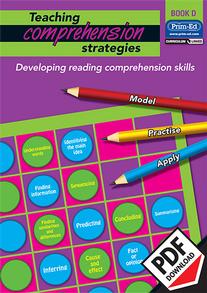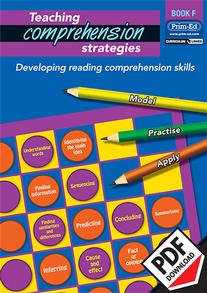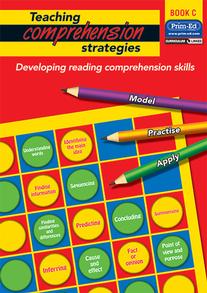-
0
Your cart is currently empty.
-
0
Your cart is currently empty.
Teaching Comprehension Strategies
Teaching Comprehension Strategies is a series of seven books, each designed to guide pupils through their comprehension development.
The Teaching Comprehension Strategies series methodically and creatively teaches pupils the strategies and skills needed for effective comprehension and prepares them for the next stage of comprehension development.
Download a free sample of Teaching Comprehension Strategies
Teaching Comprehension Strategies is designed to guide pupils through the essential stages of comprehension development. From understanding basic concepts to mastering advanced techniques, this series supports each pupil's journey towards becoming a proficient reader.
- Contemporary photocopiable series that methodically and creatively teaches pupils the strategies and skills needed for effective comprehension
- Twelve strategies covered: understanding words, finding information, identifying main idea, sequencing, comparing, predicting, concluding, summarising, inferring, cause and effect, fact or opinion, point of view
- Original fiction and non fiction texts, customised to suit the strategy being taught
- Each strategy taught through modelling and followed by practice and independent activities
- Test page provided for each strategy to aid assessment
- Detailed teachers’ notes for each strategy, including answers
- Seven-book series to cover the whole primary age range
Key features and benefits of Teaching Comprehension Strategies
Each book methodically guides pupils through their comprehension development, ensuring a solid foundation and progressive learning through:
- Comprehensive coverage: Our series spans seven books, each meticulously designed to progress pupils through the various stages of comprehension development. From early learners to more advanced pupils, this series supports each child’s journey towards becoming a proficient reader.
- Diverse learning strategies: The series covers twelve essential comprehension strategies including understanding words, finding information, identifying the main idea, sequencing, comparing, predicting, concluding, summarising, inferring, understanding cause and effect, discerning fact from opinion, and recognising different points of view.
- Engaging and relevant content: Each book includes original fiction and non-fiction texts that are specifically tailored to reinforce the strategy being taught. This ensures that learning is not only educational but also engaging and directly applicable to real-world scenarios.
- Interactive learning experience: Strategies are introduced through detailed modelling, which is then followed by a variety of practice activities. This allows pupils to apply what they’ve learned in a structured setting before moving on to more independent activities, ensuring a solid understanding of each strategy.
- Assessment tools: To assist teachers in monitoring progress, each book includes a test page for each strategy. This feature is invaluable for assessing student understanding and for providing targeted support where needed.
- Comprehensive teacher guidance: Each strategy is accompanied by detailed teachers' notes, including comprehension questions and answers. These notes provide valuable insights and tips to help teachers effectively deliver each lesson and tailor their teaching strategies to meet the needs of their pupils.
- Flexibility and scalability: The series is thoughtfully designed to cater to the entire primary age range, making it an ideal resource for schools looking to implement a consistent and effective comprehension curriculum across all year groups.
What are comprehension strategies?
Comprehension strategies are explicit instruction techniques that help pupils understand, interpret, and engage with different types of texts. These strategies empower pupils to become active readers who can construct meaning from what they read.
The strategies include inferring, summarising, making predictions, answering questions, using prior knowledge and visual cues to identify and connect the main ideas, and more, each contributing to a deeper understanding and retention of the material.
Reading comprehension skills
The series covers twelve essential reading comprehension strategies:
- Understanding Words
- Finding Information
- Identifying Main Idea
- Sequencing
- Comparing
- Predicting
- Concluding
- Summarising
- Inferring
- Cause and Effect
- Fact or Opinion
- Point of View
Explore core reading skills
The Teaching Comprehension Strategies series encompasses a complete spectrum of comprehension techniques, tailored to enhance reading comprehension through an engaging and interactive approach. Each of the seven books focuses on different aspects of comprehension, ensuring a well-rounded development of reading skills.
Ideal for teachers and pupils
Designed with the needs of both teachers and pupils in mind, Teaching Comprehension Strategies is an invaluable resource for any primary classroom. Whether you are introducing comprehension skills or looking to deepen existing knowledge, these resources offer a structured, engaging, and effective approach to learning.
Who should use this series?
- Primary School Teachers: Ideal for teachers and teaching assistants seeking structured, reliable, and effective resources to teach comprehension.
- Literacy Coordinators: Perfect for specialists aiming to elevate the school's overall literacy standards.
- Home Educators: An excellent tool for parents and guardians who are educating their children at home and want to provide a comprehensive literacy education.
Making learning comprehension fun
To transform comprehension lessons into a fun and enjoyable experience, consider the following:
- Games and Technology: Use educational games and digital tools that reinforce comprehension skills through interactive and entertaining methods.
- Creative assignments: Let pupils create content in their own words. They could write alternate endings, dramatise scenes, or create visual artwork.
- Theme days: Organise reading days or theme days where students can dress up as characters from the books they are reading. This brings the text to life and adds an element of excitement to learning.
Order your comprehension resources today!
Invest in the Teaching Comprehension Strategies series and witness the transformation in your pupils' reading abilities.
Browse our catalogue for more information or contact us directly to discuss how Prim-Ed Publishing can support your educational goals. Empower your pupils with the key to unlocking comprehension success!


















